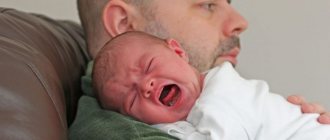Types of fractures
First of all, two types of fractures are distinguished; initially, the doctor pays attention to this:
- open - there is a violation of the integrity of the skin by parts of the broken bone, possibly the presence of a small wound, destruction of soft tissues with penetration of dirt may be observed, bleeding, both small and intense, is possible;
- closed - there is a bone fracture, which can be diagnosed using an x-ray, the skin remains intact.
The following types of fractures are also distinguished:
- compressive - one bone exerts strong pressure on another, particularly under load;
- a fracture with displacement of the arm in a child - bones move, a large area of damage occurs, nerve endings and large vessels may be affected;
- double - a fracture of the arm in two places at once, for example, the ulna and also the radius bone are broken at the same time.
Features in children
Visually, a child’s fracture has the appearance of a “green branch”. As a rule, in children there is a one-sided fracture, displacement is possible. In children, it is often accompanied by separation of the ligaments from the base of the bone.
The special specificity of children is based on the characteristics of the musculoskeletal system:
- the outer shell (periosteum) is much better supplied with blood and is denser than that of an adult;
- the bones still have growth zones;
- the presence of a large number of organic substances in the bone tissues of toddlers;
- callus forms much faster.
You need to know that in children it takes less time for fractures to heal than in adults.
However, the possibility of consequences should be taken into account:
- slowing down, then completely stopping bone growth ahead of schedule;
- shortening of a previously fractured limb;
- formation of curvatures.
You should know that children can experience spontaneous fractures, even from minor blows. Their development is caused by a deficiency of calcium in the body, a congenital disorder of mineral metabolism or acquired, which leads to the development of osteoporosis, as a result of which increased bone fragility.
Features of fractures in children
The periosteum is the outer shell of the bone; in children it is denser and much better supplied with blood. The bones have preserved growth zones and, therefore, contain a large amount of organic matter. All this causes the fragility of children's bones and a much higher incidence of fractures compared to adults.
Children's fractures are often compared to a "green branch" - by analogy with the branches of young trees, which are difficult to break but easy to bend, the child's bone is bent and broken on one side, and on the other it is held in place by thick periosteum.
Also common is a bone outgrowth fracture, which essentially means a muscle or ligament is torn off with a piece of bone. It is worth noting that fractures in children heal much faster than in adults due to good blood supply to the periosteum and, as a result, rapid formation of callus at the fracture site.
Trauma at school or kindergarten
If a child breaks his arm while in a government institution, parents should follow these steps:
- first of all, you need to examine the baby, clarify what first aid measures were provided to him;
- Next, you need to request an incident report, which should include the following points: the time when the fracture occurred; what contributed to this incident; whose fault this happened; Full name of the educator or teacher in whose lesson the incident occurred;
- Visit to the emergency room; after professional assistance provided to the child, do not forget to ask for the appropriate certificate;
- contact the administration of the school or kindergarten to resolve the situation.
Sick leave and insurance
Many parents wonder whether they provide insurance for this type of injury? The answer here is ambiguous. In fact, if you have taken care in advance of purchasing an accident insurance policy for your baby, then it will be present. However, here it is necessary to take into account that a certain amount will be paid, which does not always cover all expenses for the treatment and recovery period. This is due to the fact that children have a high percentage of injuries and insurers know this very well; they will not work to their detriment.
Regular health insurance may not provide such services free of charge.
The second question that most often worries parents in such a situation: will they give their mother sick leave? Here, too, not everything is so simple. In fact, you receive paid sick leave if a child under the age of 15 requires outpatient or inpatient treatment with the mandatory presence of a relative, that is, the baby needs careful care. And there are still some points:
- if the child is under seven years old, sick leave is given until complete recovery;
- from seven to fifteen years – up to 15 days;
- over fifteen years – three days (only in case of outpatient treatment).
It turns out that if you receive a closed fracture without displacement, you may not receive sick leave, or you may receive it for three days. But with an open one or such, when surgery was required - for a long period, and if the child is less than seven years old - until complete recovery. In fact, everything is determined by each specific case. And the duration of sick leave can be increased by the decision of the medical commission.
Therapeutic measures
Treatment of a fracture in a child can be successfully carried out at home if there are no complications. In case of a closed injury with minimal or no displacement, the doctor puts a plaster cast on the child’s limb, prescribes medications to relieve swelling and relieve pain, and releases him for outpatient treatment. A child may be hospitalized if:
- the injury is open;
- there is a large displacement of fragments;
- damaged tendons, blood vessels, nerve endings;
- there is major bleeding;
- the wound became infected;
- there are associated injuries, for example, a burn;
- the fracture line runs inside the joint;
- the child needs to have surgery.
In conservative treatment, plaster is applied so that the outer phalanges of the fingers remain open; their color can be seen if problems with blood circulation arise. If the child is being treated at home, the parents should take him to the attending physician every week for an examination until the bone heals completely. How long to wear a plaster splint depends on the type of fracture, its location, the child's age and susceptibility to treatment, but generally this period lasts one or two months.
Surgery may also be prescribed to treat a broken arm. The operation is performed if:
- Closed reduction of fragments is impossible;
- There is a risk of improper bone healing;
- The fragments pinched the nerve;
- There are many fragments present.
As a rule, the operation is performed only after the complete elimination of swelling, but it can also be done on an emergency basis if there is a need to stitch together large vessels and pull out individual bone segments.
In a comminuted fracture, the bone is held together with a plate and screws, sometimes with knitting needles, which are removed a year after the injury during reoperation. The recovery period includes massage, physical therapy, physiotherapy and a special diet rich in calcium and other minerals and vitamins. If parents notice signs of a fracture in a timely manner and consult a doctor for treatment, and then undergo rehabilitation, then the child has a very high chance of a full recovery and return to an active lifestyle.
Causes
A child in the kindergarten broke his arm while playing on the playground; the injury occurred at home. What factors provoke this phenomenon:
- the baby fell on his hand from a height, for example, jumping from a slide;
- during sports exercises under heavy load;
- due to the fall of a heavy object on the toddler’s hand;
- The baby has osteoporosis, the bones are too brittle.
You should also not forget about fractures received as a result of a traffic accident.
Causes of fractures
The main reason is a fall on an outstretched arm. This is an innate reflex that a person uses when he loses his balance. When falling, people stretch out their arms to support and protect their internal organs, face, and head. But the protective mechanism does not always work; the radius bone cannot withstand the force of the blow or the weight of the body and breaks.
Trauma can happen to anyone at any age.
Risk group : athletes, people over 50 years of age, patients with diseases of bones and joints.
Main features
If a child has a broken arm, symptoms may manifest as follows:
- strong and sharp pain at the site of suspected injury;
- puffiness and swelling;
- the presence of a special crunch resulting from the friction of two parts from a broken bone;
- limb deformation is possible.
These are the main signs; there may also be additional ones:
- inability to move the joint;
- the intensity of pain increases if you change the position of the hand;
- the appearance of cold sticky sweat;
- the occurrence of hematomas at the site of injury;
- the skin turns pale and you may feel dizzy;
- breathing and heart rate increases;
- if there is an open fracture, there is bleeding of varying intensity depending on the degree of damage.
If there are even minimal signs of a fracture, you should immediately contact a traumatologist. To make a correct diagnosis, you cannot do without an x-ray.
Features of treatment
In most cases, a broken arm in children does not require drastic measures and the application of a splint is sufficient, the purpose of which is to fix the damaged bone in the correct position. If no complications are noted, then the child is sent home after applying a cast. He will need to visit the hospital approximately once a week.
During this period, it is important for parents to monitor his well-being. If the pain begins to subside and the child does not experience pronounced discomfort, then the healing process is proceeding correctly. But there are cases when the splint was installed incorrectly, which means it requires correction. The following signs may indicate this fact:
- The pain does not decrease, and sometimes even intensifies;
- Swelling appears;
- There is a feeling of numbness;
- There is a decrease or loss of sensitivity.
If a child complains of such symptoms, you should immediately consult a doctor.
In case of complex fractures, additional procedures will be required. They may include:
- Fixing broken bones with knitting needles. First, fixation is performed, and then the splint is applied. Since it is necessary to minimize the risk of re-displacement, the patient usually comes to the hospital for dressing changes;
- Carrying out an operation. The duration of surgery depends on the complexity of the fracture. The patient is recommended to spend several days in a hospital setting.
In general, it is rare that a fracture without other injuries can lead to serious complications.
Diagnostics
To determine the presence of a fracture, the following steps will be taken:
- examination of the patient, questioning of complaints, finding out the reasons for the incident;
- the presence of the following symptoms is established: hematomas, deformities, movement disorders, swelling and soreness, crepitus;
- the general condition of the child is assessed, special attention is paid to the head, abdomen, neck, chest, the presence of reflexes and the level of consciousness are assessed;
- Radiography is prescribed in two projections. This is necessary to determine the nature of the injuries, the formation of fragments, and reveals the exact location of the fracture.
If necessary, the following are also prescribed:
- MRI;
- ultrasound diagnostics;
- consultation of narrow specialists.
We provide first aid
In case of a fracture, medical intervention cannot be avoided. Never set a bone yourself. The first task of parents is to calm the baby, immobilize him and then call the doctors.
Let's look at general measures to provide first aid.
- Using available means, immobilize the injured limb. For this purpose, cardboard, plywood, a ski pole, or newspaper folded in several layers will suit you.
- Now you need to fix the hand, it is advisable to do this with bandages or pieces of fabric. Parents should take care of the immobility of the joints between which the fracture site is located. It is recommended to apply cold.
- If you have ever broken your arm, then you probably know how much pain is accompanied by this injury. The baby cannot endure it, and he doesn’t need to. Therefore, it is important to take care of taking analgesics. For children, you can use drugs based on paracetamol or ibuprofen. For example, Nurofen has proven itself well.
- If a child has an open fracture, then first of all it is necessary to treat the torn area of skin. For this purpose, it is necessary to use any available antiseptics, for example, hydrogen peroxide. After treatment, a sterile napkin is applied to the affected area, and only then the limb is fixed.
- If there is severe bleeding due to an open fracture, then it is necessary to apply a tourniquet above the site of injury to the skin and immediately call an ambulance.
- If you notice that the baby has a traumatic shock, bring a piece of cotton wool coated with ammonia (literally a couple of drops) to his nose (at a distance of seven cm). This will help bring him to his senses.
You can also read about first aid for broken legs and nose in a child.
First aid
It is important for every person not only to acquire knowledge of how to recognize a fracture, but also to learn how to provide first aid in this case.
The amount of assistance depends on the nature of the injury. If the fracture is closed, then before the ambulance arrives, you must:
- Secure the limb, including the joints. For this you need to use hard, straight objects: sticks, a ruler. This measure will help prevent further displacement of the bones;
- Relieve swelling that occurs. This is done using a cold compress;
- Reduce pain syndrome. Painkillers are suitable for this. The type and dosage of the medicine depends on the age of the child.
If the fracture is open, it is necessary to minimize the risk of infection. The wound must be treated with an antiseptic; hydrogen peroxide is ideal. A sterile bandage is applied on top. If there is severe bleeding that a regular bandage cannot stop, a tourniquet must be used.
Regardless of the type of fracture, the following general rules must be observed:
- The child should be in a calm, or even better still, state;
- If possible, it is necessary to rid the injured limb of clothing;
- It is important to monitor the child’s condition and provide him with sufficient fluids;
- When applying a tourniquet, it is important to record the exact time.
If you take the right actions, you can alleviate the child’s condition and prevent complications from the fracture.
Treatment
First of all, the doctor will numb the baby and put a cast on the fracture site, but only after taking an x-ray and confirming the alleged diagnosis.
In most cases, hospitalization for a broken arm is not necessary. However, there are situations when it is needed:
- severe blood loss;
- there is damage to tendons and nerve fibers;
- with an open fracture, an infection has entered the wound and continues to spread;
- during a fracture, the bone is crushed into several fragments that need to be removed surgically;
- bone injury is accompanied by a severe burn;
- the need for surgical intervention.
Parents should understand that treatment can be both surgical and conservative.
- Conservative treatment is prescribed for a closed fracture, in the presence of only two bone fragments, and is accompanied by:
- pain relief with analgesics, for example, novocaine;
- the use of drugs to relieve swelling;
- applying plaster;
- tying the arm with an immobilizing bandage;
- the doctor must take care of oxygen access to the hand and ensure that the functioning of the nerve tissues is not disrupted.
- Surgical intervention is necessary for:
- damage to nerves and large vessels;
- repeated displacement of fragments;
- open injuries;
- inability to correctly compare the fragments;
- instability of bone fragments.
It must be taken into account that surgery increases the risk of damage to the germ cells of bone growth zones.
The surgery takes place under general anesthesia. Anatomical alignment of bone fragments is carried out for epiphyseal and displaced articular fractures. Fixation is performed using a Kirschner wire, which is removed after complete fusion of the bone.
For any type of treatment, the following therapy is prescribed:
- taking analgesics;
- anti-inflammatory drugs;
- drugs that increase the intensity of bone fusion;
- medications with chondroitin and calcium;
- immunomodulators;
- vitamin therapy.
For children, plaster casts are used instead of circular plaster casts.
The plaster is removed after complete fusion of the bones. This may take a month, sometimes two. This will depend on the severity of the injury, type of fracture, age of the toddler, and individual characteristics.
The success of treatment depends on:
- correctly provided first aid;
- fracture location;
- combined injuries;
- baby's age;
- severity of injury;
- timely surgical intervention;
- going through a recovery period.
Symptoms of a fracture
Displaced fractures have the following symptoms:
- strong pain;
- swelling and hematomas;
- deformation of the limb, its shortening;
- pathological mobility;
- characteristic crunching sound when moving;
- inability to perform movements.
Be sure to pay attention to the temperature of the child’s hand. If it is cold, then damage to the blood vessels may have occurred with bone fragments.
With an open fracture, a wound appears, at the bottom of which bone fragments are visible and external bleeding appears. Excessive blood loss and intense pain can lead to traumatic shock. The child's blood pressure drops, cold sweat appears, he may complain of weakness and nausea, and lose consciousness.








